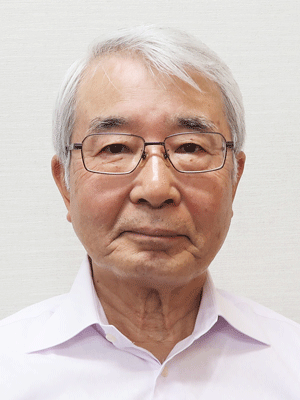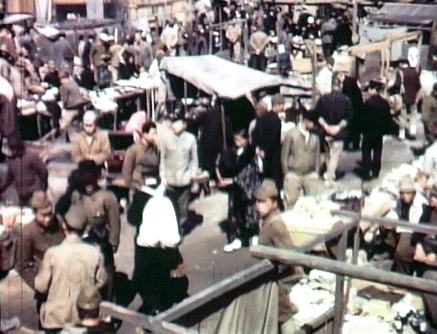Memoir of the A-bombing
I want to pass on the stories of 'The Lost Decade'
Hiroshi Shimizu
Atomic Bomb Witness for this Foundation

August 6, 1945
I was three when I experienced the atomic bombing together with my mother at my home in Yoshijima Town, 1.6km from the hypocenter.
We were inside, so we avoided any damage from the heat wave, but we were buried under our collapsed house.
My mother desperately pushed off the wood that was on top of us, got through the roof and escaped, and pulled me out.
Soon after that, the area around our home became a sea of fire, so if we had been a little later to get out I do not think we would have survived.My father was at his workplace just south of the Hiroshima City Hall around 1km from the hypocenter when the atomic bomb hit. He was thrown and his face was covered in glass, and apparently he was covered in blood down to his chest. Chased by the flames, he fled and got into the pond in front of a public hall on the north side of City Hall and passed out there, but his colleagues carried him to the Red Cross Hospital (1.5km from the hypocenter) in Senda Town. The next morning, he woke up in the hospital. He had the glass removed from his face, and somehow crawled back to Yoshijima Town, and was reunited with my mother around midday. However, even though he'd finally been reunited with his family again, he became weaker and weaker, and passed away on October 8. When he died, for some reason his entire stomach had turned a bluish-black color. When my mother saw that, she said "That's because your father inhaled a lot of gas from the atomic bomb." Now, I guess that his stomach turned bluish-black because his internal organs were destroyed because he was exposed to strong radiation at close range.
I also suffered from radiation sickness for ten years after the atomic bombing. It started with serious diarrhea, and then there was continued stomach pain, nosebleeds, Burabura illness(*) and more. I was a weak child, and during physical education class at school I just watched. However, when I reached second year of junior high school these symptoms disappeared and I got better, and I progressed through school and got a job. I had so much stamina that if someone asked me what my hobby is I would say "Mountain climbing!"
Even so, from my late forties I gradually contracted various illnesses. Even today I have intractable disease in my kidneys and spine, and also heart disease. My older brother was exposed to radiation when he went into Hiroshima city after the atomic bombing. He was very well when he was younger, but at the age of seventy-five he contracted cancer in his inner ear, and was certified with radiation sickness. In 2019 he is 87 years old, but is now fighting lung cancer. Even decades later, the atomic bomb breaks down the body and continues to cause pain―it really is a weapon of evil. I think that nuclear weapons must be eradicated from this world as quickly as possible.
The Lost Decade
I believe that my lifelong mission is to investigate 'The Lost Decade' of hibakusha and pass on our stories.
The Lost Decade is what we call the approximately ten years of suffering that the hibakusha from Hiroshima and Nagasaki went through with no support whatsoever.
This was caused by the 'Press Code for Japan' issued by the America military GHQ that occupied and controlled Japan for seven years after the war.
The Press Code prohibited any reporting about Hiroshima and Nagasaki.
Because of this, the tragedy of Hiroshima and Nagasaki was not reported and kept hidden, and the Japanese government followed this too.
This closed off any opportunities for the hibakusha to receive medical or living support from other areas in Japan or overseas, and they were abandoned by the whole world.
This part of history is forgotten today, but it is an historical fact that should never be repeated.
The black market in front of Hiroshima Station
"The stalls were around 1.8m x 1.8m.
During the day, my mother sold crockery.
At night she would put down the stall and the three of us slept there.
We lived there for around one year."
(Photograph: United States Strategic Bombing Survey)
(*) Burabura illness: a condition or illness with symptoms such as lack of emotional energy, lack of motivation to do anything, tires easily.
Cause unknown.
One after-effect of radiation sickness.
Profile
[Hiroshi Shimizu]
Born in 1942.2011: started A-bomb testimonial activities with a hibakusha organization upon feeling shocked by the nuclear accident at Fukushima nuclear power plant.
2014: for two years from 2014, appointed as director at Hiroshima A-Bomb Sufferers' Organization and Japan Confederation of A- and H-Bomb Sufferers' Organizations, learned about the hibakusha movement.
Hiroshima Peace Culture Foundation
1-2 Nakajima-cho, Naka-ku, Hiroshima 730-0811 JAPAN
TEL +81-82-241-5246
Copyright © Since April 1, 2004, Hiroshima Peace Culture Foundation. All rights reserved.